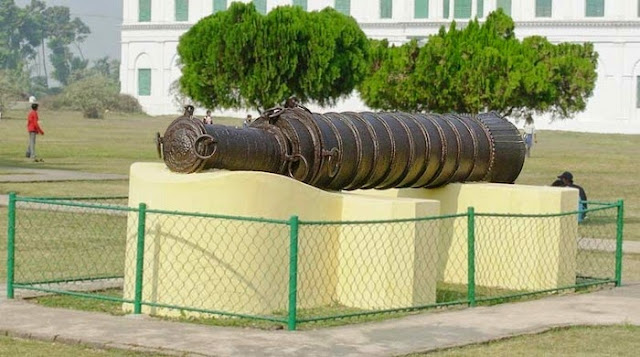 |
| Jahan Kosha Cannon,Murshidabad,W.Bengal, IndiaTrell |
 |
| Jahan Kosha Cannon,Murshidabad,W.Bengal, en.wikipedia.org |
 |
| Jahan Kosha Cannon (the destroyer of the world). en.wikipedia.org |
 |
| Murshidbad Jahan Kosha cannon en.wikipedia.org |
 |
| Location, Murshidabad, WB /en.wikipedia.org |
This remarkable cannon 17 feet and 6 inches long and 3 feet wide, has a girth of 5 feet at the touch hole end weighs more than 7 tons. The circumference of its mouth is more than one feet. The radius of the silt for containing fire is one and a half inch. 17 kilograms of gunpowder are needed for a single shelling. The orifice is 6 inches. It still shows no sign of rust despite being exposed to a variety of climatic conditions.
On instructions from Daroga Shree Mohammad and under the supervision of Hara Ballav Das in 1637 AD, this cannon was designed and made by one Janardam Karmakar who also happened to be a gunsmith. Karmakars were often blacksmiths but are capable of making cannons. Inscriptions engraved on it point out Shah Jehan was the Mogul emperor at that time and Islam Khan was the Subedhar of Bengal. However, the cannon has several other names like the "Great Gun", the "Destroyer of the world", the "Conqueror of the universe" and so on.
There is yet another astonishing, but exciting cannon with excellent fire power called Bacchawali Tope, literally it means the cannon which causes the child birth. It is on display in the Nizamat Fort Campus on the garden space between the Nizamat Imambara and the Hazarduari Palace and to the east of the old Madina Mosque in the city of Murshidabad. This was most probably made in the 12th and 14 th century by Muslim rulers of Gaur and was widely used against attackers from NW to protect the city of Murshidabad.The cannon has two parts of different diameters for better efficiency and range of fire.
 |
| ahan Kosha Cannon,Murshidabad,W.Bengal,facebook.com |
After the 1846 fire of the Nizamat Imambara, the Imambara was rebuilt, then after the completion of the new Imambara the cannon was shifted to its present site by Sadeq Ali Khan, the architect of the sacred Nizamat. It originally rested on the sand banks of Ichaganj. However, it is unknown that how it came in Ichaganj.
 |
| Bacchawali Tope Cannon, Murshidabad,W.B historyofbengal.com |
The cannon weighs around 7657 kg. and it is said that for a single shelling it requires about 18 kg of gunpowder. The muzzle of the cannon is 1 foot and 7 inches.







.webp)

